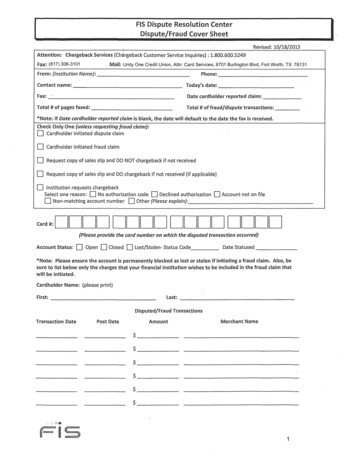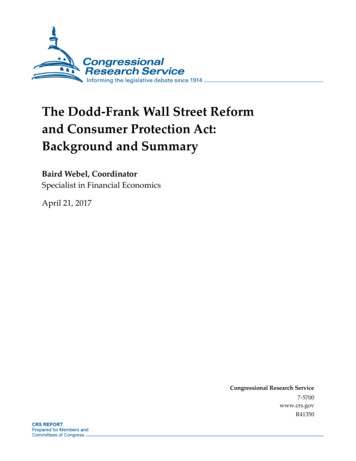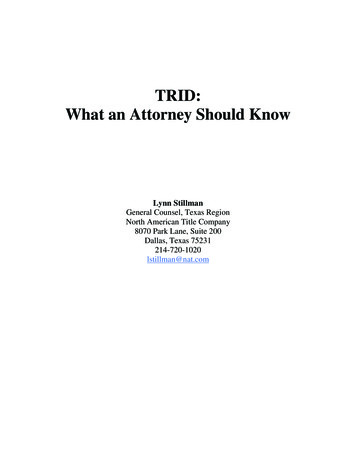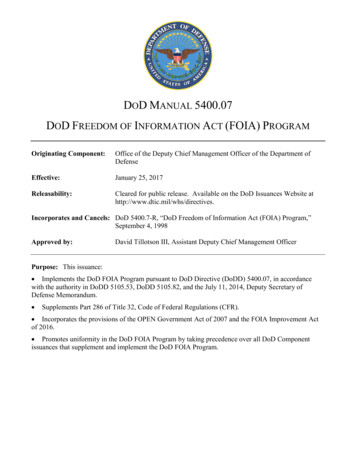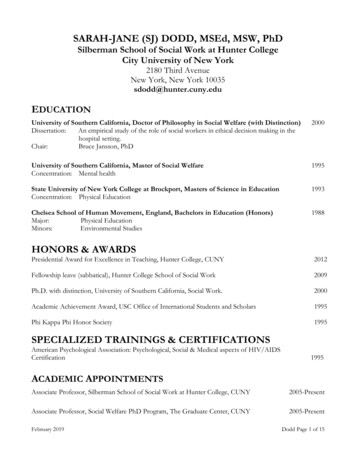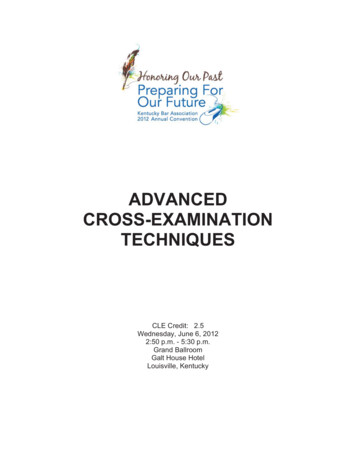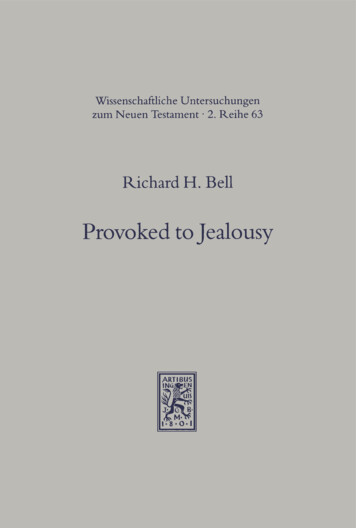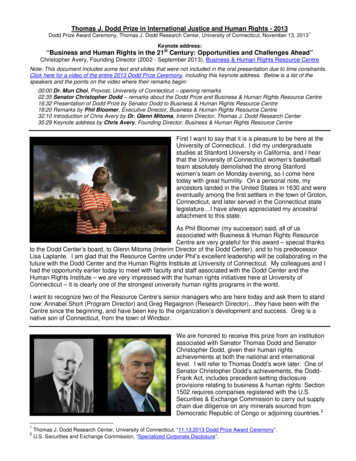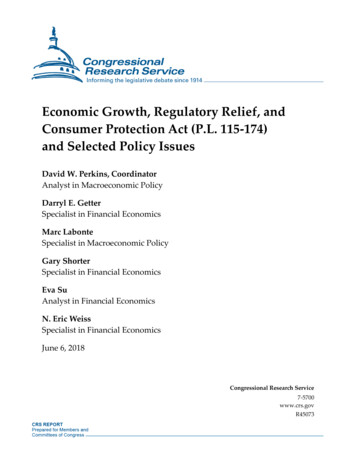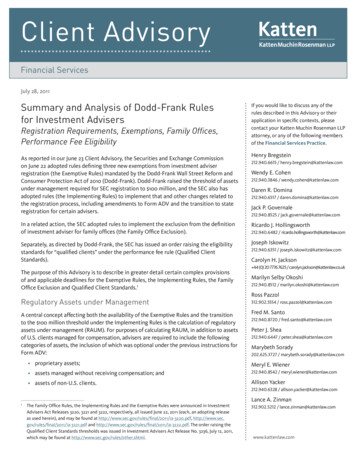
Transcription
Client AdvisoryFinancial ServicesJuly 28, 2011Summary and Analysis of Dodd-Frank Rulesfor Investment AdvisersRegistration Requirements, Exemptions, Family Offices,Performance Fee EligibilityAs reported in our June 23 Client Advisory, the Securities and Exchange Commissionon June 22 adopted rules defining three new exemptions from investment adviserregistration (the Exemptive Rules) mandated by the Dodd-Frank Wall Street Reform andConsumer Protection Act of 2010 (Dodd-Frank). Dodd-Frank raised the threshold of assetsunder management required for SEC registration to 100 million, and the SEC also hasadopted rules (the Implementing Rules) to implement that and other changes related tothe registration process, including amendments to Form ADV and the transition to stateregistration for certain advisers.If you would like to discuss any of therules described in this Advisory or theirapplication in specific contexts, pleasecontact your Katten Muchin Rosenman LLPattorney, or any of the following membersof the Financial Services Practice.Henry Bregstein212.940.6615 / henry.bregstein@kattenlaw.comWendy E. Cohen212.940.3846 / wendy.cohen@kattenlaw.comDaren R. Domina212.940.6517 / daren.domina@kattenlaw.comJack P. Governale212.940.8525 / jack.governale@kattenlaw.comIn a related action, the SEC adopted rules to implement the exclusion from the definitionof investment adviser for family offices (the Family Office Exclusion).Ricardo J. HollingsworthSeparately, as directed by Dodd-Frank, the SEC has issued an order raising the eligibilitystandards for “qualified clients” under the performance fee rule (Qualified ClientStandards).Joseph IskowitzThe purpose of this Advisory is to describe in greater detail certain complex provisionsof and applicable deadlines for the Exemptive Rules, the Implementing Rules, the FamilyOffice Exclusion and Qualified Client Standards.1Regulatory Assets under ManagementA central concept affecting both the availability of the Exemptive Rules and the transitionto the 100 million threshold under the Implementing Rules is the calculation of regulatoryassets under management (RAUM). For purposes of calculating RAUM, in addition to assetsof U.S. clients managed for compensation, advisers are required to include the followingcategories of assets, the inclusion of which was optional under the previous instructions forForm ADV:212.940.6482 / ricardo.hollingsworth@kattenlaw.com212.940.6351 / joseph.iskowitz@kattenlaw.comCarolyn H. Jackson 44 (0) 20 7776 7625 / carolyn.jackson@kattenlaw.co.ukMarilyn Selby Okoshi212.940.8512 / marilyn.okoshi@kattenlaw.comRoss Pazzol312.902.5554 / ross.pazzol@kattenlaw.comFred M. Santo212.940.8720 / fred.santo@kattenlaw.comPeter J. Shea212.940.6447 / peter.shea@kattenlaw.comMarybeth Sorady202.625.3727 / marybeth.sorady@kattenlaw.com proprietary assets;Meryl E. Wiener assets managed without receiving compensation; and212.940.8542 / meryl.wiener@kattenlaw.com assets of non-U.S. clients.Allison Yacker212.940.6328 / allison.yacker@kattenlaw.com1The Family Office Rules, the Implementing Rules and the Exemptive Rules were announced in InvestmentAdvisers Act Releases 3220, 3221 and 3222, respectively, all issued June 22, 2011 (each, an adopting releaseas used herein), and may be found at http://www.sec.gov/rules/final/2011/ia-3220.pdf, http://www.sec.gov/rules/final/2011/ia-3221.pdf and http://www.sec.gov/rules/final/2011/ia-3222.pdf. The order raising theQualified Client Standards thresholds was issued in Investment Advisers Act Release No. 3236, July 12, 2011,which may be found at http://www.sec.gov/rules/other.shtml.Lance A. Zinman312.902.5212 / lance.zinman@kattenlaw.comwww.kattenlaw.com
Also, the RAUM calculation must be made on a gross basis; advisers are not permitted to subtract any outstanding indebtednessor other accrued but unpaid liabilities (including accrued fees or expenses) that remain in a client’s account. Thus, borrowings toprovide trading leverage are included in RAUM. Although RAUM is calculated on a gross basis, an adviser may opt to report AUMon a net basis in Form ADV Part 2, and thus these two disclosures may differ.With respect to private funds, an adviser is required to: include the value of any private fund over which it exercises “continuous and regular supervisory or management services,”including the value of non-securities assets held by the fund (although a sub-adviser to a private fund will include in itsRAUM only that portion of the fund’s portfolio for which it provides sub-advisory services); include the value of any uncalled capital commitments made to the fund; and use the market value or, if the market value is unavailable, a fair value methodology to value private fund assets, but is notrequired to determine fair value in accordance with U.S. generally accepted accounting principles (GAAP), and could, forexample, utilize a fair value methodology set forth in a fund’s governing documents.Some commenters on the proposed rules objected to the use of both gross assets and fair value for RAUM calculations. The SECexpressed concern that the use of net assets could permit managers of highly leveraged funds to avoid registration, even thoughtheir activities might be appropriate for systemic risk reporting, and thus adopted the gross assets calculation methodology. Withrespect to fair value, the SEC recognized the potential increased cost to certain advisers not currently using U.S. GAAP as a resultof the need for an annual determination of fair value and provided flexibility for advisers to use fair value standards other than U.S.GAAP.The SEC was not persuaded that the requirement to include proprietary assets, assets managed without compensation and assetsof foreign clients would be problematic for some firms previously of the view that they did not have assets under management forpurposes of investment adviser registration. With respect to proprietary assets, it stated that, although receipt of compensationfor providing investment advice is a necessary requisite in order for a person to be considered an adviser under the Advisers Act,once an adviser receives compensation from any client, the SEC views that person as an adviser and deems the Act applicableto the relationship of that adviser and all of its clients. In addition, that adviser is required to include in its RAUM all assets itmanages regardless of whether those assets would not previously have been considered client assets (i.e., proprietary assets).Exemptive RulesRepeal of Private Adviser Exemption. Title IV of Dodd-Frank, the Private Fund Investment Advisers Registration Act, wasintended to require many managers of hedge funds and private equity funds to register with the SEC. Effective July 21,2011, Dodd-Frank repealed the private adviser exemption from registration under Section 203(b)(3) of the Advisers Act forinvestment advisers who (i) have had fewer than 15 clients in the preceding 12 months; (ii) do not generally hold themselvesout to the public as investment advisers; and (iii) do not act as advisers to registered investment companies or businessdevelopment companies. Because a pooled investment vehicle was generally counted as a single “client” for purposes of thisexemption, many advisers to hedge funds, private equity funds, venture capital funds and other private investment vehiclesrelied upon it to avoid SEC registration as investment advisers.New Exemptions from Adviser Registration. Although it repealed Section 203(b)(3), Congress in Dodd-Frank directed the SEC toadopt certain limited exemptions for fund managers. These Exemptive Rules are available to:(i)advisers solely to “private funds” that have less than 150 million of assets under management (now calculated as RAUM)in the United States (the Private Fund Adviser Exemption);(ii) non-U.S. advisers that have less than 25 million in RAUM from U.S. clients and U.S. private fund investors and fewer than15 such clients and investors (the Foreign Private Adviser Exemption); and(iii) advisers solely to “venture capital funds” (the VC Adviser Exemption, and collectively, the Exemptions).The effective date of all three Exemptive Rules is July 21, 2011. None of the rules is mandatory. Thus, an adviser that qualifies forany of the Exemptions may choose to register, subject to the 100 million threshold. The deadline for registration by advisers thatmust register is March 30, 2012.2
Private Fund Adviser ExemptionRule 203(m)-1 under the Advisers Act defines the new Private Fund Adviser Exemption. Under Dodd-Frank, a “private fund” isdefined as an issuer that would be an “investment company” within the meaning of the Investment Company Act of 1940, asamended (the Company Act), but for Section 3(c)(1) or 3(c)(7) thereof. The availability of the Private Fund Adviser Exemptiondiffers, depending on whether an adviser has its principal office and place of business in the United States (U.S. Advisers) oroutside the United States (non-U.S. Advisers). The SEC states that it considers the adviser’s principal office and place of business asthe location where the adviser controls, or has ultimate responsibility for, the management of private fund assets, though day-to-daymanagement of certain assets may also take place at another location.U.S. Advisers. The Private Fund Adviser Exemption is available to a U.S. Adviser that: acts solely as an adviser to one or more private funds; and has private fund RAUM in the United States of less than 150 million.For purposes of determining the 150 million RAUM limitation, Rule 203(m)-1 deems all of the assets managed by a U.S. Adviser to bemanaged “in the United States.”Thus, a U.S. Adviser would have to count all assets of the private funds it manages as assets under management “in the U.S.” evenif it has offices outside the United States from which certain assets are managed. Moreover, a U.S. Adviser would have to countall of the assets (even the assets of non-U.S. person investors) of any offshore fund it manages that relies on Section 3(c)(1) or3(c)(7) for exclusion from the Company Act because it has U.S. persons as investors. In order to rely on the Private Fund AdviserExemption, a U.S. Adviser cannot have any clients that are not private funds, whether in the U.S. or elsewhere.Non-U.S. Advisers. For a non-U.S. Adviser, the SEC will look to the investment management activities that are conducted at aplace of business in the United States, although the principal office and place of business are elsewhere. The Private Fund AdviserExemption for a non-U.S. Adviser is available if: all of the adviser’s clients that are “U.S. persons” (as defined in Regulation S under the Securities Act of 1933, as amended(Securities Act)) are private funds, without regard to the type or number of its non-U.S. clients; and all of the assets it manages at a place of business in the United States are solely attributable to private funds with totalRAUM of less than 150 million.As a result of comments it received, the SEC has made certain clarifications with respect to application of the rule to non-U.S.Advisers. First, it has clarified that a non-private fund client will not be considered a U.S. person for purposes of the rule if it wasnot a U.S. person when it became a client. In addition, in the adopting release the SEC stated that a non-U.S. Adviser need nothave a place of business in the United States to rely on the rule.The Exemptive Rules do not provide specific guidance for counting assets of non-U.S. Advisers where advice is provided by teamsor affiliates located in multiple jurisdictions within and outside the United States. While the SEC requested comment on this andother issues related to the asset calculation for non-U.S. Advisers, it determined to treat “assets under management in the UnitedStates” as those assets managed “at” a U.S. place of business. (The proposed rule defined such assets as those managed “from” aU.S. place of business.)A non-U.S. Adviser will be disqualified from claiming this exemption if it manages any assets at a place of business in the UnitedStates for clients other than private funds. Thus, it appears that a non-U.S. Adviser relying upon this exemption could not manageassets for non-U.S. clients (other than private funds) from a place of business in the United States. Conversely, it appears that anon-U.S. Adviser could advise a managed account for a non-U.S. person from a place of business outside the United States andwould be able to rely on this exemption.Single-Investor Funds. Certain commenters asked the SEC to address whether a single investor fund could be a private fund forpurposes of the exemption. The SEC expressed concern about advisers converting client accounts to single-investor funds in orderto rely on the exemption. It recognized that there may be circumstances where it might be appropriate to treat a single-investorfund as a private fund, for example, in the case of a fund seeking to raise capital from multiple investors that has only a single,initial investor for a period of time.3
Annual Determination of Eligibility. Assets attributable to private funds are to be calculated annually for purposes of determiningeligibility of an adviser for the Private Fund Adviser Exemption. (This represents a change from the proposed rule, which wouldhave required quarterly calculation.)Under the Private Fund Adviser Exemption as adopted, an adviser must determine the amount of its RAUM (as described above)attributable to “qualifying private funds,” which include funds relying on Sections 3(c)(1) and 3(c)(7) of the Company Act and mayinclude, at the adviser’s option, funds relying on other Company Act exclusions (such as Section 3(c)(5)(c) for real estate funds).Exempt Reporting Advisers. As is discussed more fully below, advisers relying on the Private Fund Adviser Exemption, as well as theVC Adviser Exemption, are now categorized as Exempt Reporting Advisers (as defined below) and are subject to significant SECreporting and recordkeeping requirements, notwithstanding their exemption from registration.Transition Period. If a Private Fund Adviser reports on its annual updating amendment to Form ADV that it has 150 million or morein RAUM of “qualifying private funds,” it must apply for SEC registration within 90 days after such amendment. If it has compliedwith all reporting requirements applicable to it as an Exempt Reporting Adviser (as discussed below), it may continue to act asa Private Fund Adviser during this period. The 90-day transition period is not available to any Private Fund Adviser that has notcomplied with all such reporting requirements or has accepted a client that is not a private fund.Foreign Private Adviser ExemptionRule 202(a)(30)-1 under the Advisers Act defines the Foreign Private Adviser Exemption. This exemption is available to an adviser that: has no place of business in the United States; has fewer than 15 clients and private fund investors in the United States; has less than 25 million of aggregate RAUM attributable to such U.S. clients and investors; and does not hold itself out generally to the U.S. public as an investment adviser.Client and Investor Counting Rules. Section 202(a)(30) of the Advisers Act provides that to be eligible for the exemption, a foreignprivate adviser cannot have more than 14 clients or “investors in the U.S. in private funds advised by the adviser.” For purposesof counting the number of U.S. clients advised by a foreign private adviser, advisers must apply counting rules substantiallysimilar to those currently contained in the “safe harbor” counting provisions under Advisers Act Rule 203(b)(3)-1, with slightmodifications. Thus, the rule permits advisers to count as a single client: a natural person and various family members and related accounts or trusts of which they are the only primary beneficiaries; a corporation, general partnership, limited partnership, limited liability company, trust or other legal organization to whichthe adviser provides investment advice based on the organization’s investment objectives; and two or more legal organizations that have identical ownership.The Foreign Private Adviser Exemption also requires that the adviser count “investors in the U.S.” in private funds advised bythe adviser for purposes of determining the adviser’s eligibility for the exemption. The rule defines “investor” to include anyperson that would be included in determining the number of beneficial owners of a Section 3(c)(1) fund or required to meetthe definition of a “qualified purchaser” in a Section 3(c)(7) fund. In addition, the SEC’s definition requires the adviser to countbeneficial owners of debt securities (including “short-term paper”) issued by the private fund, as well as “voting securities,” asunder current law.In a change from the rule as proposed, the final rule does not treat as investors beneficial owners who are knowledgeableemployees with respect to the private fund, and certain other persons related to such employees.Advisers also have to count underlying owners of fund interests, including: beneficial owners in nominee or similar arrangements; holders of instruments (such as total return swaps) that effectively transfer the risk of investing in the private fund to suchholder; and in the case of master-feeder structures, the holders of the securities of feeder funds formed or operated for the purpose ofinvesting in the master fund.4
To avoid double-counting, the adviser may count a person who has invested in two or more private funds advised by the adviser asa single investor. The Foreign Private Adviser Exemption also allows an adviser to omit counting a private fund as a separate clientif the adviser has already counted any investor in that private fund.The Foreign Private Adviser Exemption uses the term “in the United States” in a number of contexts. The SEC has defined thatterm in accordance with the definition of “U.S. person” and “United States” under Regulation S. However, under the rule, a personthat would be deemed “in the United States” at the time of any calculation of assets or investors may be excluded if such personwas not “in the United States” at the time of becoming a client or investing in the private fund.Place of Business. An adviser with a “place of business” in the United States may not rely on the Foreign Private Adviser Exemption.The Exemptive Rules define “place of business” as “any office where the investment adviser regularly provides advisory services,solicits, meets with, or otherwise communicates with clients, and any location held out to the public as a place where the adviserconducts any such activities,” which is consistent with current definitions used by the SEC and state authorities to determineregulatory jurisdiction.Threshold Jurisdictional Question. Commenters observed that enactment of the Foreign Private Adviser Exemption in Dodd-Frankpresupposed a conclusion that foreign advisers to foreign funds with U.S. investors would be subject to investment adviserregistration in the United States. In the adopting release, the SEC acknowledged the jurisdictional question and stated thatwhether a non-U.S. Adviser with no U.S. clients (but which may have U.S. investors in a non-U.S. fund client) would be subject toU.S. registration “depends on whether there is sufficient use of U.S. jurisdictional means.”Venture Capital Adviser ExemptionThe SEC also adopted the VC Adviser Exemption, although with certain significant changes from the proposal. First, the final ruleeliminates the requirement that the venture capital fund provide managerial assistance to or otherwise control its qualifyingportfolio companies. Also in response to comments, the SEC modified its previously proposed definition such that up to 20% of aVC Fund’s aggregate holdings and uncalled capital commitments may be held in assets other than “qualifying investments.” Thus,final Rule 203(l)-1 generally defines a venture capital fund as a private fund that: represents to investors and potential investors that it pursues a venture capital strategy; invests only in “qualifying investments” (discussed below) or short-term holdings (including money market fund shares),except that up to 20% of the amount of the fund‘s aggregate capital contributions and uncalled committed capital (otherthan short-term holdings) may be in a “basket” of non-qualifying investments, with assets valued for these purposes at costor fair value, consistently applied by the fund; does not borrow or otherwise incur leverage (other than limited short-term borrowing or guarantees of its portfoliocompany’s obligations); does not offer its investors redemption or other similar liquidity rights except in extraordinary circumstances; and is not registered under the Company Act and has not elected to be treated as a business development company.Investment in Qualifying Portfolio Companies. “Qualifying investments” for a venture capital fund are certain equity securities in a“qualifying portfolio company” or its parent company.Rule 203(l)-1(c)(4) defines a “qualifying portfolio company” as any company that: is not a reporting or foreign traded company (as defined in the rule); does not incur leverage in connection with the private fund’s investment in such company and distribute the proceeds ofsuch borrowing in exchange for the private fund’s investment; and is not itself an investment company, a private fund, an issuer of asset-backed securities under Rule 3a-7 of the Company Act,or a commodity pool.A company will not cease to be a qualifying portfolio company because it is “taken public” after the investment is made by theventure capital company.5
The purpose of the restrictions on portfolio company leverage was to preclude leveraged buyout funds that finance theirinvestments in portfolio companies with borrowed money from relying on the definition of venture capital fund.Representation as a Venture Capital Fund. As indicated, an eligible venture capital fund also must represent to investors andpotential investors that it pursues a venture capital strategy. The SEC stated that an adviser relying upon the VC AdviserExemption cannot, for example, identify a fund advised by such adviser as a “hedge fund” or “multi-strategy fund” or include thefund in a hedge fund database or hedge fund index. It is not necessary, however, for the fund name to include the term “venturecapital fund” in order for it to rely on the exemption.Application to Non-U.S. Advisers. A non-U.S. Adviser may rely upon the VC Adviser Exemption if all of its U.S. and non-U.S. clientsare venture capital funds, as defined.Grandfathering Provision. The SEC’s definition includes a grandfathering provision that includes within the definition of “venturecapital fund” any private fund that: (i) represented itself as a venture capital fund to investors and potential investors at the timethe fund offered its securities; (ii) has sold securities (including through the acceptance of capital commitments) to one or moreinvestors unrelated to the adviser prior to December 31, 2010; and (iii) does not sell any securities to, or accept any additionalcapital commitments from, any person after July 21, 2011.Reporting by Exempt Reporting AdvisersDodd-Frank authorizes the SEC to require Private Fund Advisers and VC Fund Advisers relying on registration exemptions(Exempt Reporting Advisers) to maintain certain records and to submit such reports as the SEC determines “necessary orappropriate in the public interest,” notwithstanding their unregistered status.Limited Reporting. The SEC has determined to use Form ADV as the primary means for collecting required information fromExempt Reporting Advisers. Accordingly, such advisers must complete a limited subset of items from Part 1A of Form ADV andfile this information through the Investment Adviser Public Disclosure system. Exempt Reporting Advisers must, among otherthings, identify their organizational and ownership information, provide details regarding financial industry activities and otherbusiness activities, including acting as a commodity pool operator, commodity trading advisor, security-based swap dealer ormajor security-based swap participant; provide the disciplinary histories of the adviser and its affiliates; and furnish informationregarding the private funds advised by such adviser. These reports will be publicly available, though this was not specificallymandated by Dodd-Frank.Exempt Reporting Advisers would not be required to complete the remaining items in Part 1A or to prepare a client brochure(Form ADV Part 2).Initial Reporting, Updating Requirements and Final Reports. Exempt Reporting Advisers are required to file their initial report onForm ADV no later than March 30, 2012. An Exempt Reporting Adviser thereafter is required to amend its Form ADV at leastannually, within 90 days of the end of the adviser’s fiscal year, and promptly if its responses to certain items become inaccurate.When an adviser ceases to be an Exempt Reporting Adviser, it is required to file an amendment to its Form ADV indicating that itis filing a final report. An Exempt Reporting Adviser wishing to register with the SEC can file a single amendment to its Form ADVthat will serve both as a final report as an Exempt Reporting Adviser and as an application for registration under the Advisers Act.Examinations. The SEC does not anticipate that it will conduct compliance examinations of Exempt Reporting Advisers on aregular basis, but has the authority to do so, and will use that authority when there are indications of wrongdoing.Subadvisers and Advisory Affiliates: Unibanco and Related LettersThe adopting release offers commentary on the application of the Exemptive Rules to subadvisory relationships and theapplicability of the registration requirements to affiliates of registered advisers.With respect to subadvisers, the SEC stated that subadvisers may rely on each of the new Exemptions, provided that they satisfyall terms and conditions of the applicable rule. It noted that in many subadvisory relationships, a subadviser has contractualprivity with a private fund‘s primary adviser rather than the private fund itself. Although both the private fund and the fund‘sprimary adviser may be viewed as clients of the subadviser, the SEC said it would consider a subadviser eligible to rely on the6
Private Fund Adviser Exemption if the subadviser‘s services to the primary adviser related solely to private funds and the otherconditions of the rule were met. Similarly, a subadviser may rely on the VC Adviser Exemption if its services to the primary adviserrelated solely to VC funds and the other conditions of the rule were met.In proposing the rules, the SEC had cast doubt about the continued viability of the line of no-action letters originating with Unibanco.2In those letters, the staff provided assurances that it would not recommend enforcement action against an unregistered non-U.S.Adviser that was affiliated with a U.S. registered adviser, despite their sharing of personnel and resources. In adopting the ExemptiveRules, the SEC responded to support in many comments for the continuation of Unibanco. However, separate from the discussionof Unibanco and the foreign/domestic context, the SEC stated that the determination of whether the advisory businesses of twoseparate affiliates may be required to be integrated is based on facts and circumstances and cited Richard Ellis, Inc., a 1981 no-actionletter, for factors relevant to a determination of whether a separately formed advisory entity operates independently of an affiliate.Family Office ExclusionIn separate action, the SEC also adopted rules to implement the Family Office Exclusion from the definition of investment adviserenacted by Dodd-Frank. In response to commenters, the SEC expanded the Family Office Exclusion rules significantly from whatoriginally was proposed. Under the new Rule 202(a)(11)(G)-1, a “family office” is excluded from the definition of an investmentadviser if it meets the following conditions: its clients consist solely of “family clients”; it is wholly owned by “family clients” and is exclusively controlled (directly or indirectly) by one or more “family members”and/or “family entities”; and it does not hold itself out to the public as an investment adviser.Family offices have until March 30, 2012, to meet the conditions of the Family Office Exclusion or to register under the AdvisersAct. Like other exclusions provided in the Advisers Act, the Family Office Exclusion is self-executing. A family office is not requiredto notify the SEC of its reliance on the Family Office Exclusion.Who Is the Family? Unlike the proposal, which defined the family based on the concept of a founder, the Family Office Exclusionallows a family office to designate a “common ancestor” (living or deceased) to define its family, provided the ancestor is no morethan ten generations removed from the youngest generation.“Family members” are all of the lineal descendants of this designated common ancestor and such descendants’ spouses or spousalequivalents. Lineal descendants include adopted children, stepchildren, foster children and any individual that was a minor whenanother family member became that individual’s legal guardian. The Family Office Exclusion also contemplates that the familyoffice may re-designate a new common ancestor over time to allow for new generations of family clients.Family Clients. The Family Office Exclusion defines a “family client” as including: “family members” (as defined above) and former family members; “key employees” (which include executive officers, directors, trustees, general partners or persons serving in a similarcapacity for the family office or its affiliated office (other than an employee only performing clerical, secretarial oradministrative functio
Title IV of Dodd-Frank, the Private Fund Investment Advisers Registration Act, was intended to require many managers of hedge funds and private equity funds to register with the SEC. Effective July 21, 2011, Dodd-Frank repealed the private adviser exemption from registration under Section 203(b)(3) of the Advisers Act for
